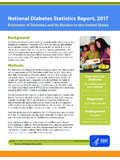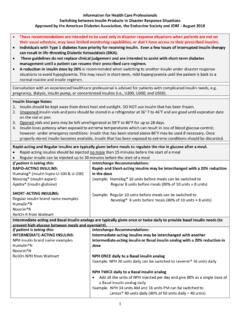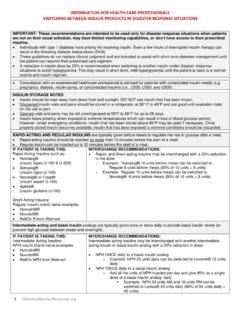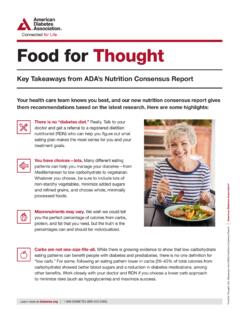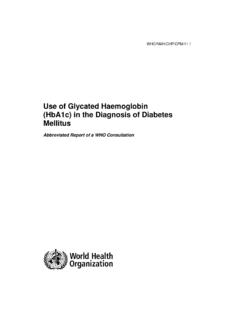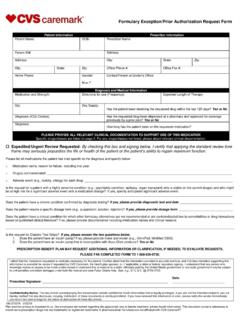Transcription of Federal Motor Carrier Safety Regulations Part 391 ...
1 Federal Motor Carrier Safety Regulations Part 391 Diabetes Comparison of Old and New Rules Old Rule (with Diabetes Exemption Program) New Rule Citation(s) 49 CFR (b)(3) 68 Fed. Reg. 52441 (Sept. 3, 2003) amended by 70 Fed. Reg. 67777 (Nov. 8, 2005) 49 CFR (b)(3); (e) (new); (new) 83 Fed. Reg. 47486 (Sept. 19, 2018) Applies to All interstate commercial Motor vehicle drivers with insulin-treated diabetes All interstate commercial Motor vehicle drivers with insulin-treated diabetes Medical evaluation by Board-certified or Board-eligible endocrinologist Treating clinician, defined as individual authorized by state where licensed to prescribe insulin Minimum period of insulin use Individuals newly diagnosed with type 1 diabetes: 2 months Individuals with type 2 diabetes converting to insulin.
2 1 month 3 months, with flexibility (see below on blood glucose records) Disqualifying hypoglycemia Severe hypoglycemia, defined as loss of consciousness or seizure, requiring the assistance of another person, or resulting in impaired cognitive function which occurred without warning symptoms. Severe hypoglycemia, defined as an episode of hypoglycemia requiring the assistance of others, or resulting in loss of consciousness, seizure, or coma. Hypoglycemia unawareness should be considered by treating clinician in determining whether individual has stable insulin regimen and proper control of his or her ITDM. Includes episodes of severe hypoglycemia that occur while individual with ITDM is off-duty.
3 Period of disqualification No recurrent (two or more) hypoglycemic reactions resulting in a loss of consciousness or seizure, requiring the assistance of another person, or resulting in impaired cognitive function which occurred without warning symptoms within the past 5 years. A period of one year of demonstrated stability is required following the first episode of hypoglycemia. If an ITDM individual has an episode of severe hypoglycemia, he or she is prohibited from operating a CMV until the treating clinician evaluates and determines the cause has been addressed and the individual again has a stable insulin regimen and properly controlled ITDM. Once the treating clinician completes a new assessment form following the evaluation, the individual may resume operating a CMV.
4 Episodes of severe hypoglycemia must be reported to the treating clinician as soon as is reasonably practicable. No maximum permitted episodes of severe hypoglycemia. Each episode triggers evaluation by treating clinician and return to driving only if found to have stable insulin regimen and properly controlled ITDM. Blood glucose records A CMV driver should not have large fluctuations in blood glucose levels. The determination of a patient s stable control is left to the treating endocrinologist, who must review the driver s daily blood glucose logs. Driver must provide records of all daily glucose measurements taken with an acceptable device (with memory), and these measurements must be reviewed by the endocrinologist on a quarterly basis.
5 Endocrinologist certifies that all daily glucose measurements correlate with the daily records of driving time. Endocrinologist must review 5 years of driver s medical history. All ITDM individuals must provide to the treating clinician at least the preceding 3 months of blood glucose records while using insulin to be eligible for up to the maximum 12-month medical certification. If an individual does not provide 3 months of records, the medical examiner may grant up to a 3-month medical card to allow time for the individual to collect the necessary records. Individuals with ITDM must maintain blood glucose records measured with an electronic glucometer that stores all readings, records the date and time of readings, and from which data can be electronically downloaded.
6 A printout of the electronic blood glucose records or the glucometer must be provided to the treating clinician at the time of any evaluation. Handwritten blood glucose records are not acceptable. Self-monitoring may be performed by finger stick or continuous glucose sensor. Frequency of blood glucose monitoring Check blood glucose before starting to drive and take corrective action if necessary. If glucose is 100 mg/dl, take glucose or food and recheck in 30 minutes. Do not drive if glucose is <100 mg/dl. Repeat the process until glucose is >100 mg/dl. While driving check glucose every 2-4 hours and take appropriate action to maintain it in the range of 100-400 mg/dl. If glucose is >400 mg/dl, stop driving until glucose returns to the 100-400 mg/dl range.
7 If more than two hours after the last insulin injection and eating, take additional insulin. Recheck blood glucose in 30 minutes. Don t resume driving until glucose is <400 mg/dl. No specific frequency of blood glucose monitoring or blood glucose level requirements. Individuals with ITDM must self-monitor blood glucose in accordance with specific treatment plan prescribed by the treating clinician. Single test results Silent An individual with ITDM should not be disqualified for a single blood glucose reading that falls below or above a specific limit. Treating clinicians may set individualized, clinically-based parameters for blood glucose and should look for frequent occurrences of low blood glucose levels and determine the cause.
8 Blood glucose while operating a CMV Check blood glucose before starting to drive and take corrective action if necessary. If The treating physician is in the best position to determine the specific blood glucose glucose is 100 mg/dl, take glucose or food and recheck in 30 minutes. Do not drive if glucose is <100 mg/dl. Repeat the process until glucose is >100 mg/dl. While driving check glucose every 2-4 hours and take appropriate action to maintain it in the range of 100-400 mg/dl. If glucose is >400 mg/dl, stop driving until glucose returns to the 100-400 mg/dl range. If more than two hours after the last insulin injection and eating, take additional insulin. Recheck blood glucose in 30 minutes.
9 Don t resume driving until glucose is <400 mg/dl. monitoring plan, including monitoring requirements while driving a CMV, and whether the submitted blood glucose records are consistent with the plan. A1C No specific A1C level required by the Diabetes Exemption Program, but a complete medical examination by an endocrinologist includes a report with two measures of glycosylated hemoglobin, the first 90 days prior to the last and current FMCSA Medical Examiner Handbook states, Hemoglobin A1c (HbA1c) greater than 10% is an indicator of poor blood glucose control. It is recommended that you obtain further evaluation or monitor the driver more frequently to determine if the disease process interferes with medical fitness for duty and safe driving.
10 No specific A1C required. A1C values should not be relied upon as a sole measure of an individual s ability to safely operate a CMV but are one factor the treating clinician may consider. ITDM Assessment Form asks if individual has had A1C measured over the last 12 months and to attach the most recent measure within the preceding 3 months but the lack of A1C data does not automatically disqualify an individual. Where available, most recent A1C should be attached to form and made available to medical examiner. Vision Annual certification by an ophthalmologist or optometrist that there is no proliferative diabetic retinopathy and no clinically significant disease that prevents the individual from meeting the current vision standards at 49 CFR (b)(10).

